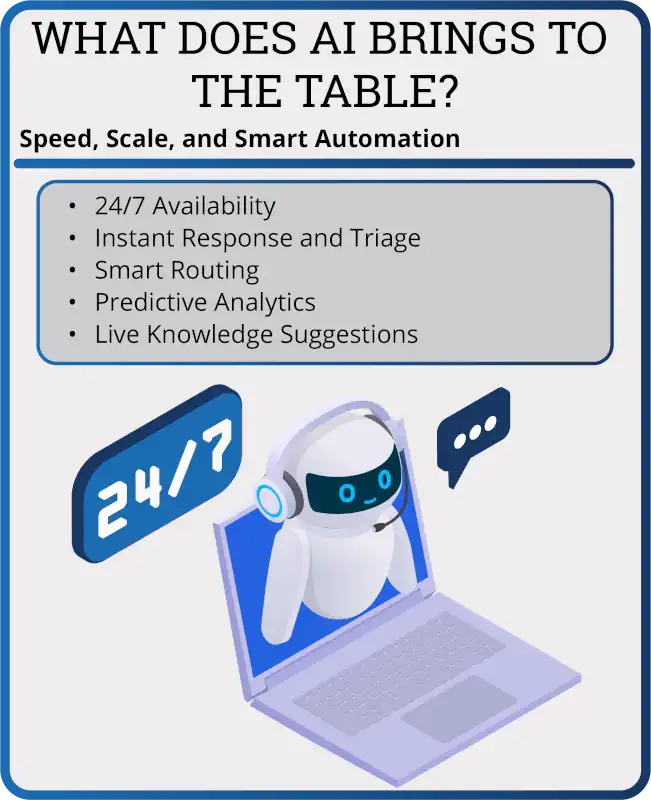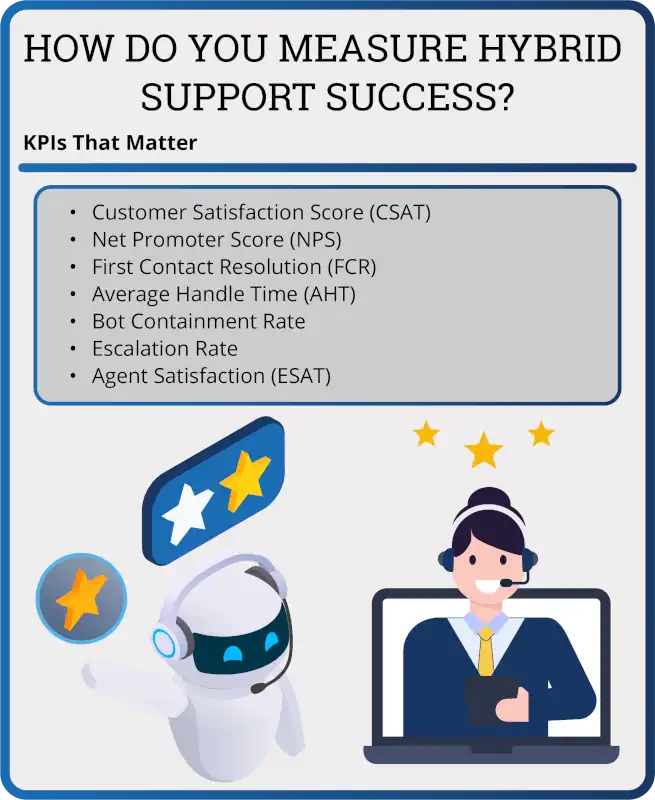When customers reach out to a call center, it’s often because they need help right away. In those moments, they expect more than just a quick fix—they want personalized solutions and a smooth experience. The challenge for support teams is delivering on those expectations while handling growing volumes of inquiries, tighter resources, and rising pressure to perform.
Artificial Intelligence (AI) has quickly emerged as a solution to this challenge, offering the potential to increase efficiency while improving customer satisfaction. But AI alone isn’t enough. Human agents bring emotional intelligence, empathy, and creative problem-solving—traits that machines simply can’t replicate.
In this blog, we explore how to strike the perfect balance between AI automation and human empathy. We'll break down what each brings to the table, where they fall short, and how leading organizations are combining their strengths to build a modern, responsive, and emotionally intelligent support model.
What Challenges Are Today’s Call Centers Facing?
Call centers are under more pressure than ever before. Customers expect fast, personalized service across multiple channels, and their inquiries are increasingly complex. As self-service options handle simpler issues, frontline agents are left managing emotionally charged and high-stakes interactions.
In addition to rising expectations, the types of issues call centers handle have evolved. Basic questions are often deflected to chatbots and knowledge bases, which means agents now receive fewer—but more complex—inquiries. This puts enormous stress on staff and operational systems. Without intelligent support tools, it's difficult to keep up with demand while maintaining service quality.
AI enters this environment not as a replacement but as a transformative force—one that reshapes workflows, reduces stress, and enhances the support experience. Let’s dive into top strategies to elevate your customer support strategy, ranging from AI transformation and hybrid models to building customer trust and tracking the right performance metrics.
What Does AI Brings to the Table?
Speed, Scale, and Smart Automation
AI is already deeply embedded in the daily operations of modern call centers. From intelligent call routing to voice-enabled automation and real-time agent support, AI delivers faster, more consistent, and personalized experiences—often without the customer even realizing it.
Key capabilities include:
- 24/7 Availability: Offers continuous service across all time zones and channels.
- Instant Response and Triage: Reduces queue times and prioritizes customer needs.
- Smart Routing: Uses sentiment, language, and intent to connect customers with the right support.
- Predictive Analytics: Identifies customer patterns, preempts issues, and offers tailored responses.
- Live Knowledge Suggestions: Equips agents with real-time, context-aware guidance during calls.
As a result, AI doesn’t just help with volume—it improves the quality of every interaction by offering consistency and reducing human error.

What is the Human Advantage over AI?
Empathy, Nuance, and Complex Resolution
Despite the rise of automation, human support remains essential. AI can mimic certain patterns, but it lacks emotional depth and contextual understanding.
Human agents offer:
- Emotional Intelligence: Empathy in customer service helps ease tension, especially when emotions run high.
- Creative Problem Solving: Human intuition allows for non-linear thinking in complex or unique scenarios.
- Relationship Building: Real conversations build trust and loyalty that drive long-term retention.
- Ethical Reasoning: Humans are better equipped to handle edge cases and moral dilemmas where rules don't apply cleanly.
While AI can help answer a billing question, it can't console a frustrated customer or calmly handle a customer who's had a poor experience with a service. These situations demand human connection.
Where Does AI Shine and Humans Struggle?
Efficiency, Consistency, and Scalability
AI thrives in areas where speed and consistency are paramount—things that human agents can struggle with under pressure or at scale.
AI excels at:
- Repetitive Inquiries: It can quickly handle FAQs, shipping updates, password resets, and appointment scheduling.
- Instant Information Delivery: Delivers accurate responses based on structured data and knowledge bases.
- Smart Prioritization: Flags escalations for urgent attention, ensuring fast human handoff.
- Multilingual Support: Supports global operations without requiring native speakers.
Humans, while empathetic, can suffer from fatigue, forgetfulness, or inconsistency—especially during peak hours. AI brings balance by filling in those gaps and enabling smoother operations.

How Can You Empower Agents Through AI?
From Automation to Augmentation
AI isn’t just customer-facing. When used as a support tool for agents, it becomes a force multiplier.
AI empowers human agents by:
- Reducing Repetitive Tasks: Automates post-call summaries, data entry, and case tagging.
- Providing Real-Time Coaching: Offers scripts, policy reminders, or empathy prompts during live interactions.
- Improving Onboarding and Training: Personalized microlearning modules can accelerate ramp-up time.
- Balancing Workload: Intelligent routing distributes calls evenly, reduces burnout and improves agent engagement.
Ultimately, AI frees agents to focus on what they do best, delivering human, high-value conversations that build customer satisfaction and loyalty.
Where Does AI Needs Guardrails in the Call Center?
Ethical, Reliable, and Responsible Use
Like any powerful tool, AI must be used responsibly. Without proper oversight, it can lead to serious pitfalls.
Key concerns:
- Data Privacy and Security: Mishandled customer data can lead to compliance violations and erode trust.
- Bias in AI Models: AI trained on biased data may produce unfair or discriminatory outcomes.
- Over-Surveillance: Using AI to constantly monitor agents can backfire, damaging morale and increasing turnover.
- Inadequate Integration: If AI isn’t synced with CRMs and ticketing platforms, it causes more friction than it resolves.
For AI to thrive, organizations must adopt transparent policies, conduct regular audits, and involve frontline teams in shaping how AI is used.

How Can You Build Customer Trust in AI?
From Algorithmic Anxiety to Confidence
Many customers feel uneasy interacting with bots—especially when they aren't aware if they’re speaking to a machine or a person. This "algorithmic anxiety" is real, but solvable.
Ways to build trust:
- Disclose the Use of AI: Let customers know when they’re interacting with automation.
- Clearly Communicate Benefits: Focus on reduced wait times, faster resolutions, and 24/7 support.
- Provide Human Escalation Options: Always offer the choice to speak to a live agent.
- Collect and Act on Feedback: Regularly assess customer satisfaction with AI tools and make improvements.
The more seamless and transparent the experience, the more comfortable customers will become. Confidence in AI builds confidence in your brand.
How Do You Measure Hybrid Support Success?
KPIs That Matter
To ensure the AI-human balance is working, organizations must measure both qualitative and quantitative metrics.
- Customer Satisfaction Score (CSAT): Measures perceived experience quality after interactions.
- Net Promoter Score (NPS): Captures customer loyalty and likelihood to recommend.
- First Contact Resolution (FCR): The percentage of issues resolved in one touchpoint.
- Average Handle Time (AHT): Tracks resolution speed and call efficiency.
- Bot Containment Rate: Indicates the percentage of issues resolved fully by AI.
- Escalation Rate: Reveals how often bots hand off to humans—and why.
- Agent Satisfaction (ESAT): Measures how supported and empowered your human team feels.
These metrics help continuously refine your support strategy—ensuring you're not just tracking volume, but quality and impact.

How to Strike the Balance and Lead the Industry
AI is reshaping customer service—but not by replacing humans. It’s amplifying their strengths, reducing their workload, and enabling them to offer more value where it matters most.
At SQM Group, we believe the future of customer support is collaborative. By designing systems where AI and humans work in tandem, businesses can deliver faster, smarter, and more meaningful interactions at scale.
To move forward successfully:
- Invest in agent training that emphasizes empathy and adaptability.
- Implement AI responsibly, with privacy and fairness at the forefront.
- Track KPIs that measure both efficiency and emotional connection.
- Ensure seamless AI-human handoffs to protect the customer experience.
Success isn’t about choosing sides—it’s about building a partnership between people and technology. Those who do it well won’t just meet rising expectations—they’ll redefine what great customer service looks like.
By implementing AI in a way that complements—not competes with—your human workforce, you create a customer experience that is both efficient and deeply human.
That’s the future of exceptional support.
